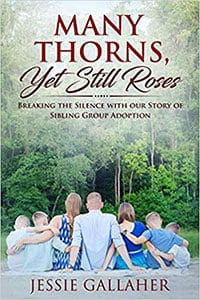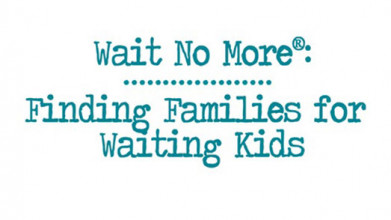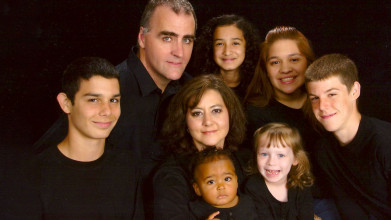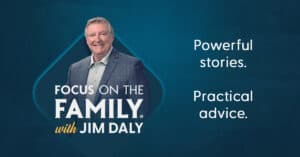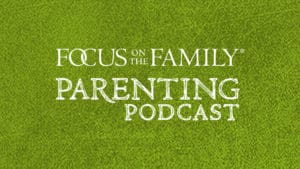Excerpt:
Jessie Gallaher: When we first brought the kids home, so many people told us, “Just love on them and time will heal it.” And I didn’t believe that that was true because that’s not the same when you raise a child without any kind of trauma background. You need structure. You need consistency.
Jim Daly: Right.
Jessie: And you need some of those hard conversations to take place. You can’t just love or at least not in that way. You have to love through consistency and structure as well.
End of Excerpt
John Fuller: That’s Jessie Gallaher. And she shares about her beautiful and complicated life as a foster mom and adoptive mom. And this is Focus on the Family. I’m John Fuller. Your host is Focus president and author Jim Daly. And Jim, I’ve got to say, we do a lot of radio programs here. This is one I’m really interested in because, as an adoptive dad, I know that a lot of things can go sideways quickly…
Jim: Yeah.
John: …When we bring children into the home that haven’t been with you previously. And it’s a real challenge sometimes.
Jim: It can be. And I think that’s one of the great reasons that we went to air this broadcast today. There’s victories. And then there’s sometimes defeats. And that’s the adventure of adoption, whether it’s through foster or, uh, domestic adoption or international adoption. We’re speaking to everybody. And maybe you’re thinking about it. And that is something that warms my heart. I was that foster child. And, uh, you know, that – that experience was not very good. And I am desperate to beg, cajole, uh, Christian families to consider either foster adoption or at least entering the foster system to be a safe, loving home for these kids temporarily or to be a respite giver, to give the care to the foster family or the adoptive family. Just do the laundry or do something to help them out. We can do this together as a community of believers. The numbers are not that big when you look at the number of churches. We have about 350,000 churches in the United States, more there in Canada. And then we have about 400,000 in the foster system — about 100,000 that are looking for adoptive homes where the parental rights have been terminated. That shapes it up. That’s like one adoption for every three churches. I think that’s manageable.
John: Hmm.
Jim: And think of the families of those churches would come around that one family. We’re going to hear about it today. And again, I’m going to tell you boldly. Our goal is to convince you that this is a call of God (laughter), that you need to be engaged somehow. Kids need loving homes. “No better home,” as one social worker once told me – there are no better homes for these kids than Christian homes. We just need to step up.
John: Hm. Well, May is National Foster Care Awareness Month. That’s one of the reasons we’re talking about that now. And our guest has a heart for these foster children. She and her husband adopted five siblings out of foster care.
Jim: What? John say that again. What?
John: (Laughter) Five kids at once!
Jim: (Laughter)
John: Instant family – and, well, the amazing, challenging stories are going to flow today, I think.
Jim: They really are. Uh, Jessie, it is great to have you. You’ve done this wonderful work, this book, Many Thorns Yet Still Roses – love the title…
Jessie: Thank you.
Jim: …Subtitle being, Breaking The Silence with Our Story of Sibling Group Adoption.
Now, it’s all roses, right?
Jessie: (Laughter) It is not all roses. But I would say that when people want to look at things like adoption in context of only victories or failures…
Jim: Right.
Jessie: …You got to be able to see where a victory is coming through a hardship. And so, one of the things that we learned very early on is that when things seemed to be going more wrong than usual, typically a breakthrough is on the horizon. And so, um, even our first weekend with the kids at home – one of them fell apart and had a very, very, uh, violent meltdown.
Jim: Yeah.
Jessie: And in that, it was able to show us that, wow, this kid’s already thinking we might be trustworthy and willing to start pushing buttons.
John: Hmm.
Jessie: And so, as we were going…
Jim: See. That’s so interesting, though. You got to slow down because people – I mean that really – most parents and most people aren’t used to that. What these kids are saying is, “There have been so many people in my life…”
Jessie: Uh-hm.
Jim: “…That when I push buttons, they back away. It demonstrates they don’t really care about me.”
Jessie: Yeah.
Jim: And that’s true in foster care.
Jessie: I feel like these kiddos – they have already been hurt by someone in their past. And in that scenario, you don’t want to take a risk on trusting someone again and fearing that hurt. And so, if you push those buttons upfront and see if that person stays with you through your intentional worst then they’re going to stick with you when you’re giving your best and sometimes mess up.
John: Hmm.
Jim: Well…
Jessie: And they have to see that to start with.
Jim: And you and your husband have done such a great job with this. That’s why we wanted you on the broadcast. I mean, families struggle in this space. You’ve taken on the challenge. You’ve adopted these five kids. That is huge. Most people are going, “Why? Why did you do that?”
Jessie: (Laughter).
Jim: That would be a rational response. I mean, it’s taking on a big burden. So, let me ask that question that we hear from the listeners screaming through the microphones right now. Why? What motivated you to get involved?
Jessie: So, when I was in elementary school, I had a friend who was in foster care. And we had a very close relationship. And then just one day I came to school, and she was gone. And that was such a hardship for me. And I was – I was still in my home. This girl – she lost her friends and the home she was in and everything else attached to it. And I still don’t know where her life ended up taking her.
Jim: Huh.
Jessie: My husband also had a story in his youth of a child who deserved a better home situation. And so, we both separately knew that adoption would be in our story. But we didn’t know exactly how it would play out. And after getting married and my husband joined the army, God kind of gave us some basic guidance that we thought we were following. But then a door would close here or something new would open here. And it would shift around until we had finally landed on this sibling group of five. And the flyer we saw resembled my husband’s family to himself. And he dropped his head and said, “Oh no. I think God wants us to take all five.” And I thought, “Oh no. I see – I see that, too (laughter).”
Jim: You didn’t say, “Honey, you need to keep praying…”
Jessie: (Laughter).
Jim: “…Because I’m not hearing that from God?”
Jessie: Right? Well, we went through the process knowing we wanted kids who otherwise were less likely to be placed. We wanted older kids in a sibling group because those are the ones that are typically forgotten.
Jim: Give the statistics on that. It’s heart-wrenching.
Jessie: Oh my gosh. When you look at the kids who are over the age of 8, it completely plummets. Their – their likeliness is practically non-existent. It’s almost like a miracle when they are taken in…
Jim: Right.
Jessie: …Versus a baby coming up for adoption. It would be mind-blowing if that child wasn’t selected right away.
Jim: So, think of that. You and your husband purposefully, uh, said to the social worker, I guess, or the caseworker, “We’re looking for this.” And they probably were like, “What?”
Jessie: (Laughter).
Jim: I mean, they don’t get that a lot because…
Jessie: They – she was shocked.
Jim: …They know there’s more problems with the older kids, typically.
Jessie: Right – she was shocked for us. And she was worried for us…
Jim: Right.
Jessie: …All at one time. And so, they want to check to make sure that you’re coming into it with a clear expectation. And the expectation we had was you can’t expect what’s coming. You can’t anticipate it. What you can know is that when you follow with God, He’s going to put steps in place for you. And so whatever obstacles come, there’s going to be a way through. It may not always be what you would anticipate from a healthy home. But there’s going to be something to move through it. And so, for us, we started to feel the push that there are kids here who are susceptible to trafficking and to prostitution and to all kinds of scary things…
Jim: Hmm.
Jessie: …Drugs, alcohol, abuse within foster care. And we wanted to make sure that the kids that we have in our schools, in our communities, in our neighborhoods had better than that. As Americans, we can provide better for our kids who are sitting around scared of what’s around them. And so, the foster care thing wasn’t where we started. But I had gone to a church conference that was talking about trafficking. And I was sad at the number of kids who end up running away from foster care because, as older children, they don’t feel like they belong. And I feel like our kids should belong.
Jim: Jessie, I want to move this along to your particular situation. You did adopt five children.
Jessie: Yes.
Jim: One of the kids, uh, struggles.
Jessie: And that is my oldest son. And what we think is, beneath all of the trauma, there is also some sort of processing hardship. And when you look at that – if there was a child with a special needs in a healthy home, the way that they’re able to gain support and resources is incredible. There’s so much available to them. But when you take a child who’s already struggling with something and compound it with trauma, that kid’s going to have an uphill road to work through. And I can tell you that with my child, uh, Brandon, he was – I mean, like I said, the very first day he was with us, he actually knocked our wall off the hinges. And it was – I had never seen anything like it. He lost his mind because somebody else got a turn on a game.
Jim: Yeah.
Jessie: And so, he was so stuck. And this child – we have worked through so many things with him where he still works through things. But we now have a relationship where he receives the help in working through things. And he has relationships with teachers. And he has friends at school and so many things that were never there before. We still have a long ways to go. But this kid, who was so burdened by his trauma, is now funny and witty. And…
Jim: Boy, to see that blossom.
John: Hmm.
Jessie: Oh, my goodness. I can’t even put words to it. And there, um – there are times where his processing – he’ll say something that – that cracks us up. I mean, just last night, my best friend – her birthday is on Valentine’s Day. So, my son who doesn’t have a girlfriend says, “Uh, Valentine’s Day – it’s such a waste of a day.”
(LAUGHTER)
Jessie: My daughter – my daughter looks at him and says, “But it’s Auntie’s birthday.” And he says, “Oh, every year?”
(LAUGHTER)
Jim: No, every other year, actually. That works out just right.
Jessie: Right? Right? And that’s actually what my best friend said. She said, “I’ll take it. We’ll only count a few of these.” And so, just those moments where he can be funny – and he – it’s – whether he’s intentional or not, he’s in conversation, and he’s participating. And he’s really thriving in a lot of ways.
John: Hm.
Jim: Hm.
Jessie: Two years ago, coming into a school, I already knew, ooh, this teacher’s going to have a bad year. I’m so sorry. And then as the year progresses and they get to know the kids, they see that, oh, you’re not intentionally doing this. There’s just a skill we need to work on here. And they come in alongside and learn to love on our kids in very special ways. I mean, I would say that my son – he is certainly noticed in his school. He stands out. But he’s one of the principal’s favorites. And we know this because the principal goes out of his way…
Jim: Because he visits the principal a lot?
(LAUGHTER)
Jessie: He does. Oh, my goodness! And there are phone calls!
Jim: I may have another thought for you. No, that’s good. I get what you’re saying.
Jessie: Right. And there are phone calls where we can laugh, and we can enjoy. And it’s no longer, “Oh, your kid is being bad.” It’s, “Oh, we got stuck on this. Can you help us with the explanation?”
Jim: Boy, that is good. That doesn’t always happen that way.
Jessie: No.
John: Yeah.
Jessie: No.
Jim: So, you’ve managed that really well.
John: Hmm. Well, we’re talking about the rather messy things that happen in families, which is part of everybody’s story but particularly when you open your heart and bring in some foster kids. And, uh, Jessie Gallaher has written this great book, Many Thorns Yet Still Roses. We’ve got it at focusonthefamily.com/broadcast. Or call us, if you’d like to learn more about what we’re encouraging you to do. And that is consider how you can help in the foster care system. Our number is 800, the letter A and the word FAMILY.
Jim: Jessie, I really appreciate the dose of reality. And this is what, you know, many of the kids are going to test you because they – they find it difficult to trust…
Jessie: Right.
Jim: …Because they create those bonds. And then they’re broken, of course, their strongest bond being with their biological mom or dad…
Jessie: Right.
Jim: …Or both. And then they’re not there for a variety of reasons. Unfortunately, in the system today, a lot of that is drug-related.
Jessie: Yes.
Jim: Opioid abuse has skyrocketed the foster – and overloaded the foster system in some states.
Jessie: Yes.
Jim: So that’s the backdrop. The kids are struggling emotionally.
Jessie: Uh-hm.
Jim: Let me ask you this. In terms of temperament, um, people, especially, I think, people of faith have great intentions. But God has wired you in a certain way.
Jessie: Yes.
Jim: Uh, I would think you and your husband are experiencing this.
(LAUGHTER)
Jim: Your husband’s a military man.
Jessie: Uh-hm.
Jim: I think that background, frankly, could be quite advantageous for the foster child in terms of discipline and, uh, boundaries and…
Jessie: Structure.
Jim: …Those kinds of things, the structure that that all brings. Some parents may struggle with this. Speak to that reality of how you wired your temperament and where it can harm and help a foster child.
Jessie: So, I know that when we first brought the kids home, so many people told us, “Just love on them and time will heal it.” And I didn’t believe that that was true because that’s not the same when you raise a child without any kind of trauma background. You need structure. You need consistency.
Jim: Right.
Jessie: And you need some of those hard conversations to take place. You can’t just love or at least not in that way. You have to love through consistency and structure as well. Routines are very important. When you take on a child and you tell them, “Hey, I’m going to adopt you, and I’m going to make you mine.” Well, that’s all good and well. But they’re still going to raid the pantry and hide it in their pillowcases and in the vents and in other spaces because what if it isn’t all it’s cracked up to be? And then as time…
Jim: Right. And it’s born out of fear.
Jessie: Absolutely.
Jim: They fear they’re not going to have enough…
Jessie: Absolutely.
Jim: …Even though your pantry’s full.
Jessie: And the self-reliance – they are trying to figure it out on their own because they don’t know that they can count on someone else. And we all work through that in developing relationships and skills. But we typically work through it with the guide of good relationships. These kids are needing a first place to start. And so, as they’re working through it, I know that, for us, our – my breakthrough moment of – oh my gosh – this consistency, that it feels like it’s boxing me in is now letting them out. And we can live together. This breakthrough story – we were sitting at a McDonald’s and it was a dollar Happy Meal night.
Jim: (Laughter).
Jessie: And I had two of my kiddos on the – the bench across from me. And one of them had to go to the bathroom. So, we stood up to get out. The one who was sitting next to him assumed the kid would step in front. So, he leaned backwards as the kid actually stepped backwards. He fell over the edge of the booth. And he fell and pancaked onto the floor. And it was like a nice slap sound. Right as he hit, the lady who was walking by stepped on his fingers, too.
Jim: Oh.
Jessie: So, this terrible moment for this kid who actually turned and reached for me.
Jim: Uh huh.
Jessie: He reached for me.
Jim: Yeah.
Jessie: He didn’t curl into his fetal position. He didn’t cry in his own pain and misery. He reached for someone to be of help. And so, when so many people start on a journey like this, that breakthrough moment seems so far away because it is a breakthrough. It’s not something that, you know, a couple days in and then this shift is going to happen. You provide consistency and routine.
Jim: Yeah.
Jessie: And you follow through on your words. And over time, as trust develops, they’re going to make a change. And when they do, the door is now open for you to come in even closer.
Jim: It’s such a beautiful story. And I think, even in our own experience, fostering, we’ve seen that. You know, we had one little boy, 2, 3 years old. And he stuttered the first three or four weeks that we had him. And really to Jean’s credit – you know, she worked with him and just assured him and loved on him. And it was, uh – it seemed like a miracle. I mean, I came home one day. And boom, the stuttering was gone. But that’s another beautiful picture of…
Jessie: Right.
Jim: …Just those – those little things that you can do that give them that stability…
Jessie: Right.
Jim: …That security, that comfort. With Brandon, you also had, I think, a Thanksgiving story.
Jessie: (Laughter).
Jim: And I love these stories. And I share – the stories are so critical because people connect with those stories.
Jessie: Right.
Jim: And this can be your story of salvaging a human life…
Jessie: Yeah.
Jim: …In the name of Christ. But what was Brandon’s story at Thanksgiving?
Jessie: So, our Thanksgiving story was a really hard one. We, um – especially in that first year, we had a lot of daily difficulties with Brandon. And on this Thanksgiving, it seemed like it amped up. And it was so hard when we just wanted to have a nice family holiday. And at the end of the night, I spent the time in my closet praying out to God like, “Why is this my life? Why are we here? I’m doing everything I can. I’m following Your lead. Why is this still what our family looks like?” And I didn’t feel an instant response. I didn’t feel an answer. And when I got up the next morning, it was such a moment of, did He walk us into this and just drop us here? Like, was this a joke?
John: Hmm.
Jim: Huh. That’s a fair question.
Jessie: Did we misinterpret it?
Jim: Yeah.
Jessie: So, as I was getting breakfast ready the next morning, I was just feeling so defeated. And Brandon walked up to me unprompted and said, “Hey, Mom. I’m really sorry yesterday went so bad. I wanted it to be a good day.” The fact that he…
Jim: Yeah.
Jessie: …Took responsibility and acknowledged that the day didn’t work out – it was the first time that he’d ever done that. And so, it was a day that got worse that led to him wanting to take a step forward.
Jim: He was beginning to see it and to rationalize it…
Jessie: Right.
Jim: …Think it through.
Jessie: Right.
Jim: That’s a big day!
Jessie: Absolutely. And then it goes to show that I think that him wanting a special holiday contributed to the chaos of the day.
Jim: Yeah.
Jessie: And for a lot of these trauma kiddos, the extra stimulation – at times, it can be hard. And so, it falls on us to walk alongside them even better.
Jim: Yeah. And Jessie, I can’t end today without, um, talking a little bit about you and Jordan and your marriage because this can put a lot of stress on your marriage…
Jessie: Yeah.
Jim: …Especially if you haven’t gone through having children already.
Jessie: Right.
Jim: And I really applaud your courage. I’m like your mom and dad going…
(LAUGHTER)
Jim: …”Really? This is what you want to do?” But I love it because it’s the heart of God.
Jessie: Right.
Jim: And it’s coming out. And you’re risking.
Jessie: Right.
Jim: And that’s the heart of God. And you’re laying it out there for these kids.
Jessie: Right.
Jim: And that is all awesome.
Jessie: (Laughter) I’ll tell you that when we started the process and we were all excited and happy like any new expectant parents – and, oh, we’re going to do sports. And we’re going to braid hair. And we’re going to make messy meals. And the kids came home. And there was a huge curve of, oh, this is what it looks like.
Jim: Right.
Jessie: We needed to adapt to what the reality was. And in those first several months, he and I had never been closer. And it was out of the survival of knowing that you had to lean on your spouse. So, as the kids were like feral cats kind of running around and, “You get this one! I got this one! Where’s this one? Eyes on this one!” and the shuffle that was taking place, I had to count on him. I couldn’t second-guess him. And he didn’t have the time to second-guess me. And then you get into a phase of where it’s still chaotic, and we can’t blame it on the kids. And we can’t blame it on our – like, there’s just – well, who do you start to nitpick at then?
Jim: (Laughter).
Jessie: So, there was a small phase of the nitpicking. And then I think the best thing happens where you start to realize, you know, even when things aren’t tough, you’re here in the trenches with me. You’re the only one…
Jim: Yeah.
Jessie: …Sitting here in the trenches with me, listening and accepting God’s call right alongside. And so, I feel like even when things are chaotic, your relationship can really benefit from being tested in that way.
Jim: I think one of the great challenges we face as the Western culture when it comes to this – and I’m sorry if this offends. And I’m laying it on myself. And I’m still struggling with this. It’s selfishness.
Jessie: Uh-hm.
Jim: Which, when you think of your walk with Christ…
(LAUGHTER)
Jim: …You know, and He says, “I want to make you more like Me.” And you say, “Oh, Lord. I want that. I want to be more like You.” And then He says, “Well, that means you’re going to be selfless.”
Jessie: Mm.
Jim: “Uh, I don’t want that part.”
Jessie: (Laughter) Right.
Jim: I mean, we don’t say it. But it is so true.
John: Mm hmm.
Jessie: Right.
Jim: Are you really willing to lay your life down for somebody? Oh, yeah because that gets me an A plus in spiritual class.
Jessie: Yeah, right.
Jim: But when it really comes down to doing it, it’s hard because we’re selfish creatures.
How – how did you manage your time?
Jessie: (Laughter).
Jim: How did you and Jordan, your husband – where did you get time? You can’t leave these kids with babysitters because they’re ill-equipped.
Jessie: Right. Right.
Jim: So, what do you do?
Jessie: I agree. It is very hard. And you end up – I think that the most precious thing for me is that if someone had asked me, with a very clear image of what this life would have looked like, “Can you handle this?” I don’t think I would have been able to say yes on the front end. But what I do know is that God saw something in me. And He brought it out along the way. And so, those pieces – those pieces that didn’t fit perfectly on the front side – He used my strengths and abilities that I didn’t know I had. He used Jordan’s strengths and abilities that I didn’t know he had (laughter). And as we walked through it, you – you find a new version of yourself.
Jim: Huh.
Jessie: And I think that if someone had asked me how I would have handled some of these circumstances on the front end, I wouldn’t have had the answer on that front end. But I do know that when you care about your kids and you care about following God, you’re going to get creative. And things will start to come into place. I don’t think you need to have all the answers in advance. I don’t think God’s ever promised us the answers in advance. But what he has said is that we need to follow Him.
Jim: Yeah. Jessie, I mean, we have flown through this time together. But I think this last comment is the most important, perhaps. The kids are all, I think, in their teen years now.
Jessie: My youngest is 8 and my oldest is 15.
Jim: OK. So, they’re moving along.
Jessie: Yeah.
Jim: And they’re doing better. That’s what I’m hearing you.
Jessie: Yes. Yes, every one of them.
Jim: And it’s still work. But it – it’s moving in the right direction on a compass.
Jessie: Yes. Yes.
Jim: Maybe not the protractor every day.
(LAUGHTER)
Jessie: Right. My youngest – he – when he first came to us, he was scared to even smile or pout…
Jim: Think of that.
Jessie: …Or make fright facial expressions because it hadn’t really been modeled for him. And he hadn’t been supported in taking those vulnerable risks of showing how you feel. And so, we started off with putting blinders up on both sides of our faces so that he and I could make faces at each other…
Jim: Right.
Jessie: …And build over time. And we’re now – we’re about to hit our five-year mark. And this kid’ll look at me. And he’ll give me a glare, or he’ll give me a frown.
(LAUGHTER)
Jim: He’s learned the facial expressions.
John: It worked.
Jessie: He’ll stick his tongue out at me.
Jim: Good for him.
Jessie: I give him good news. And he lights up.
Jim: Aw. That’s good.
Jessie: And the smile that comes off his face – so all of – every single one of the kids has victories like that…
Jim: Yeah.
Jessie: …Where the things they were stuck with – we’ve moved on. We’re facing new obstacles now.
Jim: Well, I’m sure, as we all are with, uh, teenagers.
(LAUGHTER)
Jessie: Yes. Yes.
Jim: But this is it. When you look at the – the long view…
Jessie: Mm hmm.
Jim: …When you project out there when these kids are in their 30s – man, what an investment into eternity…
Jessie: Yes.
Jim: …That you and Jordan have done. And that really is the reward in your heart.
Jessie: I feel like…
Jim: That you put them on a good path, right?
Jessie: I feel like the most important part for them is to show them that they are loved because, if we can help them to see it, then they can receive it from God, too.
If we let these kids continue to feel unworthy or failures or, unwanted – that’s a forever thing for them. And so, whether they end up becoming neurosurgeons or not, I just want them to know that they are loved. And that has enabled them to achieve skills and abilities that they wouldn’t have without the support.
Jim: Yeah. That is so well said. Jessie, man, this has been so good. You’re speaking to my heart. I’m back at that 9-year-old phase going, “Oh, man.”
(LAUGHTER)
Jim: “That’d be awesome if you would have adopted me.”
(LAUGHTER)
Jim: But it is great that you’re doing this with these kids. And I just cheer you on. I want to give you a chance. Speak to the listener who’s, “OK. Wow. This is interesting.” They’re going to sit down at the dinner table tonight, husband and wife. They’re going to talk about this. Make your pitch.
Jessie: So, I believe that there are many ways to get involved. And, obviously, the top tier would be take in some kids who have a need. And whether that leads to adoption or not…
Jim: So, start with fostering.
Jessie: So, with fostering, when you take kiddos into your home, you are changing their life. And even though it’s scary and hard on the front end, God’s going to walk you through it and there will be blessings in your life because of it. You don’t know what those blessings are in advance because we can’t bargain for it. But you will look back and see where they are. Moving into adoption, that kiddo never has to worry about where they’re going to call home again. There is no better gift that you can give to a child.
Jim: Yes.
Jessie: When you know that there are families who are doing that and you want to see a little bit of what it looks like, I feel like the context has not been spread very easily for us to peek in on what those families go through. You can also pray. That is such a big piece because I feel like when people come together in unity, we can – we can get God’s ear. And even for me, particularly, even if we aren’t getting the prayer we’re asking for, the fact that someone is praying for a solution – they’re now seeing a problem that they hadn’t in advance. And they might be used to answer it in a way that they wouldn’t have if they didn’t sit down to pray alongside you just to begin with.
Jim: So true. I mean, that’s one of the reasons we started Wait No More, which is the program that we’ve been doing now for 11 years. We’ve had over 4,000 families start the adoption process. We don’t know because of – you know, uh, privacy reasons, we don’t know the end result. But we anticipate over 4,000 children have been adopted out of foster care because of that. We’ve expanded that now to encourage people to simply get into the foster system to become that foster parent. And that’s a process. You have to be licensed by the state and all those good things. But like I said at the beginning of the program, uh, they need loving homes for these kids and no better place in a Christian home, in my opinion.
Jessie: I agree.
Jim: And then in addition to that, you can also be that respite-giver. It’s a big word that simply means be the caregiver to the family.
Jessie: Right.
Jim: Bring over the meal. Do the laundry for them.
Jessie: Right.
Jim: Statistics show that it takes about four or five families to wrap around an adoptive family so that they have the best chance of success. Just think of that in your church. Find somebody in your church that has adopted out of foster care.
Jessie: Yeah.
Jim: And be willing to say, “I’ll be that – that supportive family for you.” And here’s the amazing thing with Wait No More, we have this down, it costs $50 to help a child get placed into a loving, Christian home.
John: Hmm.
Jessie: Aw.
Jim: So, if you want to do that along with prayer, support it financially. Help Focus on the Family do all we can do together. Be a part of it. To bring that loving home to a waiting child. And if you can do that, man, we will say blessed are you.
John: Well, do join the team. Support Focus on the Family’s Wait No More effort. Find resources, all sorts of resources, including, of course, Jessie’s book Many Thorns Yet Still Roses. Uh, all of this and more at focusonthefamily.com/broadcast. Or call 1-800, the letter A and the word FAMILY.
Jim: Jessie, again, so good – thank you for being with us. Thank you for what you and Jordan are doing. And God bless those children that you’re helping.
Jessie: Thank you.
John: And if you can send a gift of any amount to Focus on the Family today, either a one-time donation or a recurring contribution to our ministry needs, we’ll say thank you by sending a complimentary copy of Jessie’s wonderful book. On behalf of Jim Daly and the entire team, thanks for listening today to Focus on the Family. I’m John Fuller inviting you back as we once again help you and your family thrive in Christ.











